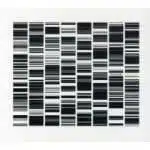
In this day and age, it’s rare to find music of a kind one truly hasn’t heard before. Everything seems to be a synthesis of something, and genre names now reach four words just to come up with something new. For the truly open-eared, however, Raster-Noton performs the miraculous task of providing music you didn’t even know you wanted to hear. Aurally, the Raster-Noton “sound” could be loosely described as an assemblage of clicks, cuts and other sonic artifacts, with occasional forays into lush, minimal ambience. Each release crafts these sounds with an approach unlikely to be anything heard before.
Enter Test Pattern, the latest full-length from Ryoji Ikeda. The pop-art bar codes adorning the cover are, in fact, part of the score of the music contained within. Test Pattern’s compositions come about through the feeding of data into Ikeda’s custom programs for conversion into audio form. The results, expectantly, prove of the experimental variety. When patterns of rhythm do arise, they are brief and not at all anchored in traditional structures from any branch of music that can be notated on a staff. All digital music classifies as data in origin; Ikeda just cuts out the middleman.
An attempt of any kind to review the album track-by-track would prove pointless. Test Pattern captivates as a whole work unto itself, lacking any singles or other such familiar tropes to the world of popular music. Like label-mate Alva Noto, Ikeda inhabits the continuum of artists who blur the line between audio research and audio-listening product, recalling James Tenney’s groundbreaking work at Bell Labs. With the range in frequency and velocity of tones and noise bursts on Test Pattern, the album could even be used as a test record for audio equipment (a usage, in fact, suggested by Ikeda, probably not at all tongue-in-cheek). Further establishing supremacy of conceptual fruition over traditional listen-ability, copies of the album brandish a sticker that warns listeners of speaker and eardrum damage if played at high volumes. By comparison, the parental-advisory stickers Tipper Gore motioned for in the 1980s look tame.
If anything’s missing, it’s a full-on treatise and/or documentary on Ikeda’s conversion process. Sources for data include text, photos, films and sounds converted to binary forms of data, then layered and manipulated to produce the results. Finally, the carbon-based life forms can empathize with the machines that read the raw data to produce our entertainment! The net effects are interesting enough, but a nagging curiosity persists as to how Ikeda performed the conversions to data, and, even more interestingly, to music. Careful listening reveals differences in deep bass tones across tracks, with identifiable impulses and noises of all colors skidding about. Revisiting the data-reading machine analogy, then, perhaps the inability to know what the data our ears are “reading” represents yet another effect of authenticity.
Ikeda has worked with similar sounds before, with Test Pattern the latest entry in his ongoing Datamatics series, which includes both sound recordings and reportedly mind-bending live audiovisual performances. It’s difficult to definitively recommend this release, as a vast number of potential listeners will unquestionably be turned off by its relentlessly challenging structure. Acquiring Test Pattern is more like buying a work of art than a collection to be revisited in bite- (or byte-) sized chunks. Like many great works of experimental music, if you can convince your mind to forget everything you know about harmonic and rhythmic structures, it’s an unforgettable listen.
